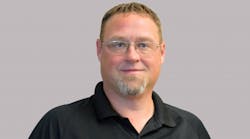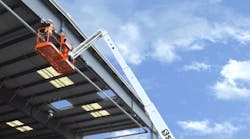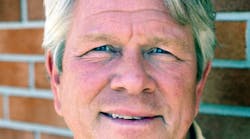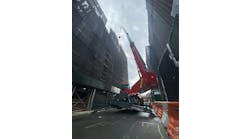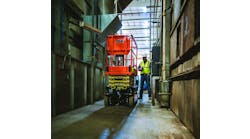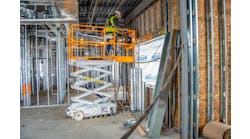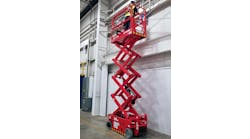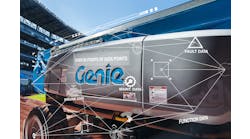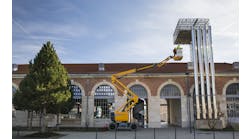RER interviews Snorkel CEO Matthew Elvin about the company’s technological developments such as the Snorkel Guard, the low-level arena, global aerial growth and more.
RER: What are the most important technological developments in aerial work platforms in the past year or so?
Elvin: From a safety perspective, secondary guarding has been one of the biggest developments across the AWP industry during the past 12 to 24 months. There are multiple systems on the market. At Snorkel, we introduced Snorkel Guard as a standard feature on all of our new build boom lifts with working heights above 40 feet, since 1st September 2015, and also made the system available as a retrofit solution for all existing Snorkel booms in the field.
Snorkel Guard is a simple, mechanical system that features a spring-loaded rail above the upper control panel that cuts out machine operations when compressed, for example, in the case of the operator being involuntarily pushed against the controls.
What do you expect in the coming year?
One of the key trends that I am seeing in the AWP industry from customers globally is the request for higher platform capacities, particularly with boom lifts. I expect that we will begin to see responses to this request from manufacturers over the next 12 months.
At Snorkel, we have already introduced our new mid-size telescopic boomlift family with a 600-pound (272kg) capacity platform as standard, and will be continuing to focus on this area within our future product development. We have a large number of new products underway, with many due to launch at ConExpo 2017.
We truly believe that listening to and responding to customer feedback and demand is critical to our success in what is an extremely competitive market.
What are the most compelling developments in the low-level access area? Is this a growing market segment?
The low-level access market is continuing to grow, driven largely by the replacement of traditional low-level access methods, such as ladders, podiums and scaffolding towers, for safety and productivity benefits. At Snorkel, we offer both push-around and self-propelled low-level access solutions. However, we are noticing an increase in inquiries for self-propelled units, such as the Snorkel S3010E.
The Snorkel S3010E is a self-propelled version of our 10-foot platform height mini push-around scissor lift. Fitted with skid steer for a zero inside turning radius, the compact S3010E is an efficient solution for low-level work at height projects that require the operator to travel distances between jobs.
Snorkel is continuing to invest in product development in the low-level access sector, and unveiled an electric drive version of its popular 12-foot Snorkel TM12 self-propelled telescopic mast lift at Bauma 2016. The TM12E has electric drive that delivers significantly longer duty cycles over the traditional hydraulic drive version. The Snorkel TM12E will be available to order from Q4 2016.
Sum up what your company has done technologically recently that is unique?
We are utilizing both electronic engine and hydraulic controls to optimize the demand of the hydraulic system to a reduced engine output. Essentially we manage the traction circuit high pressure to limit the machines drive speed when traversing rough or uneven terrain, making it easier to comply with EPA regulations by installing reduced horsepower engines whilst maintaining optimum machine performance. We are also looking into electric drive and electric supplemental systems to reduce engine requirements and to offset the cost and complexity of future emissions regulations.
What is likely to be new at the 60, 80, and 100 foot levels?
This sector of the market is fairly well developed. Further innovations in this sector will either come from customer feedback, such as the requirement for larger platform capacities, or from product redevelopment by the manufacturers. For example, at Snorkel we have recently launched a brand new line of mid-size telescopic boomlifts, with four models from 40 feet to 66 feet.
These brand new models incorporate many new features that are a direct result of our understanding of our customer base, especially the rental industry. This includes a large 600 pound (272kg) capacity tri-entry, quick-disconnect platform that includes a light-duty built-in panel carrier, removable floor paneling, Snorkel Guard secondary guarding, and all function proportional controls.
We have seen tremendous growth in the AWP segment. Still I’m sure there are some industries that are open for growth, and geographic regions where there is ample room for adoption of AWPs. What are some of your thoughts about this?
Globally, the aerial work platform market still presents a lot of opportunity for manufacturers. In mature markets, such as the United States, opportunities can be found in new sectors where AWPs have not traditionally been used, but provide a safer and more productive method of work at height than the methods that have previously been deployed. The development of specific product types, such as low-level access, and large booms, also help to open up new market opportunities for aerials in these markets.
There are also still many international markets that have huge potential for growth, particularly those that currently have limited work at height regulations. These markets include China and India. Southeast Asia is a region that is currently growing thanks to increasing regulations, led by Singapore. Global contractors who work in these regions often bring their international health and safety standards which also helps to drive the development of the rental industry and availability of the latest equipment into a region.
There have been great advances in safety in the aerial industry. What are some concerns in the safety arena?
The biggest concern within the aerial work platform industry globally is how we ensure that the equipment is only used by competent operators, who have received adequate training for the specific type of lift that they are using, in the specific environment.
Another concern is the selection of the equipment. It is essential that customers, whether renting or purchasing access equipment, are effectively supported through the process to choose the right AWP for the job by knowledgeable and well trained representatives.
How would you assess technological advancements in electric units, hybrids and alternative fuels?
Globally, there is a focus on reduced emissions, which is driving demand for electric, hybrid and alternative fuel types for equipment, and therefore driving investment in technological solutions from manufacturers. The Tier 4 regulations have also had an effect on this, as contractors may opt for alternative power sources to avoid having to ensure compliance with the latest standards.

